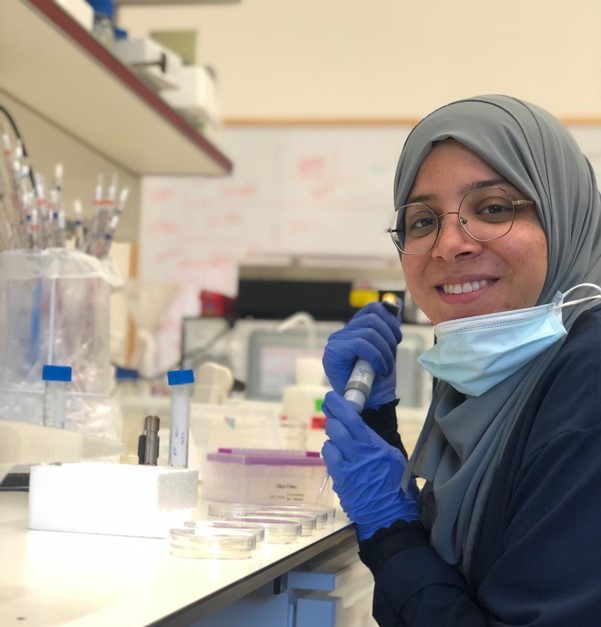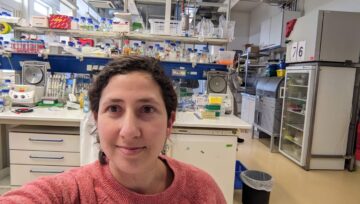SPOTLIGHT ON RESEARCH
PAPER OF THE MONTH May 2023
The Committee for Graduate Studies in the Faculty of Biology selects the leading scientific article each month from all the scientific articles published for that month.
We are pleased to announce that the winner of May’s article is Reemy Ali Nasser from Assistant Prof. Stern’s lab. The article was published in eLife.
On the occasion of the win, we asked Reemy to provide us with some interesting details about the study, the path that led to the research, and a bit about her.
Hi, could you introduce yourself in a few words?
Hi, my name is Reemy, I live in Nazareth. I did my undergraduate studies at the Technion in the Medical Laboratory track. During the last summer semester I did a research project in the lab of Professor Dan Zelberstien at the Faculty of Biology studying how Arginine starvation affects Leishmania promastigotes growth and its effect on Arginine transporter expression. I was inspired by the research process and therfore I joined the lab of Dr. Shay Stern later on to do my master.
Could you explain what Assistant Prof. Stern’s Laboratory is all about?
Organisms including human beings exhibit dynamic long-term patterns of behavior that are constantly changing across different developmental stages and are synchronized with their development time. In addition, individuals within the same population show unique patterns of behavior across long time periods that distinguish them from each other, a property known as individuality. In the lab, we investigate the molecular and neural basis of long-term behavior and individuality across the whole developmental trajectory. We use the tiny C. elegans worm that only reaches 1mm long because of its short development time (2.5 days) and the self-fertilizing reproduction mode. We monitor the locomotion of isolated worms across development using a newly developed imaging system to extract behavioral parameters.
Could you tell us about your current article/research what was the main purpose of the research and what did you discover?
The main purpose of our research project is studying how the early environment affects long-term behavior and individuality across development. Since early life experiences, and specifically stress ones, are known to induce long-lasting effects, we chose to study how early life starvation affects developmental behavior and individuality.
Animals that experienced starvation early in life exhibited lower activity not only during the first developmental stage but also during the adult stage. Therefore, the starvation effect was buffered during the intermediate stages as the activity levels were maintained. We found that two neuromodulators, serotonin and dopamine, are the ones who are responsible for the separated and opposite effects. While serotonin works early and late during development to induce sensitivity to starvation, dopamine works during the intermediate stages to buffer the starvation effect.
Using an unsupervised approach (developed by Yuval Harel), we identified new individuality types that are distinguishable from the classic consistent individuality definition. We discovered that within the same population there are multiple individuality types that are dynamically regulated by the starvation experience and the neuromodulatory state of the animals.
Can you elaborate on the importance of the discovery? How will it serve you and what directions does it take? What is the application of the discovery (domains, solutions)?
The early environment is a major factor that shapes the behavior of organisms allowing us to understand the context dependency as well as to dissect the complexity of the neural system that can manifest different outputs using the same elements. The uniqueness of our research is the longitudinal monitoring across the whole developmental stages which allows extended and accurate measurements of the environmental effects on behavior.
Furthermore, the behavioral monitoring of isolated individuals using the newly developed imaging system allowed us to discover the existence of unique individuality types within populations that are dynamically regulated by the early environmental experience. This discovery shows that individuality is a dynamic property of the population which is modified in response to external stimuli reflecting the nervous system plasticity and opening a new window for further investigation regarding the sources of behavioral variation.
What drew you to the current lab/project?
- The opportunity to ask big questions and answer them.
- Neuroscience is an intriguing field for me, specifically behavioral Neuroscience. It is incredible how signals within the nervous system are translated into appropriate behaviors in a tiny worm.
- The scientific inspiration of the PI and his tremendous knowledge.
When you are not “doing” science, what do you do?
Reading books, walking outside, and meeting family and friends.
When you grow up who do you want to be?
An “inspirational” person who can induce creativity in surrounding people at work or in personal life.
➡ Click here to read the full article
➡ Click here to view the Assistant Prof. Shay Stern’s lab site









